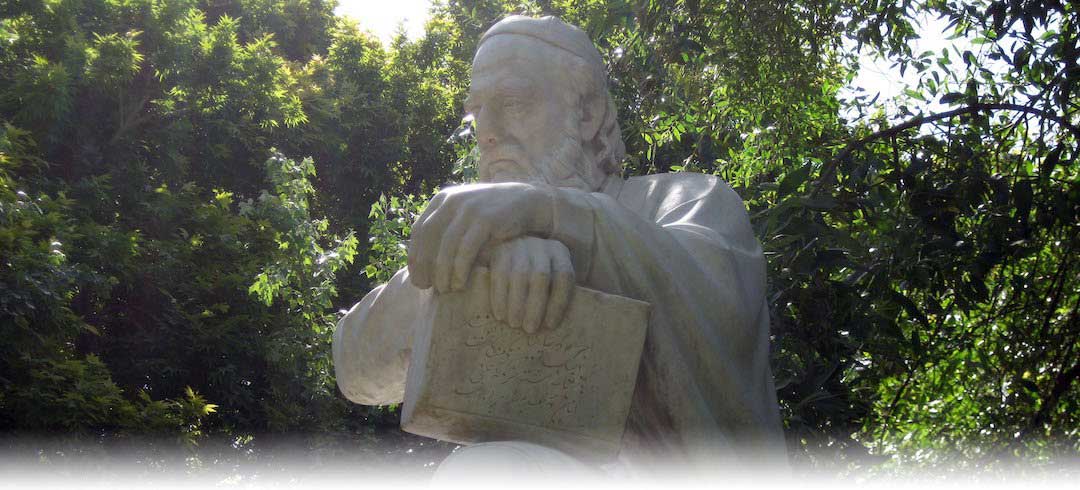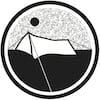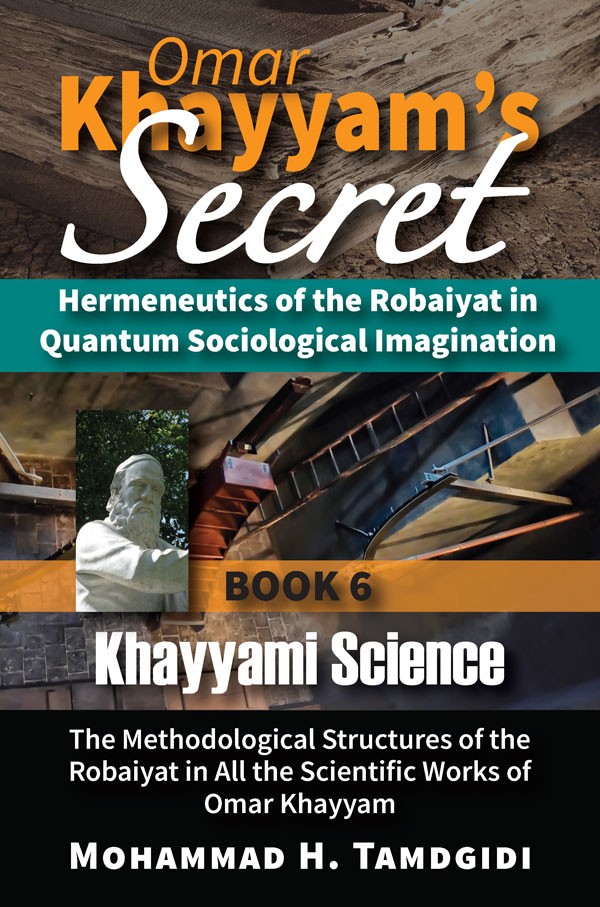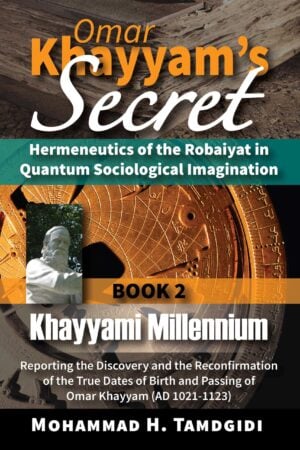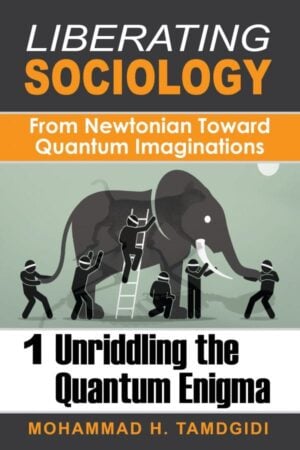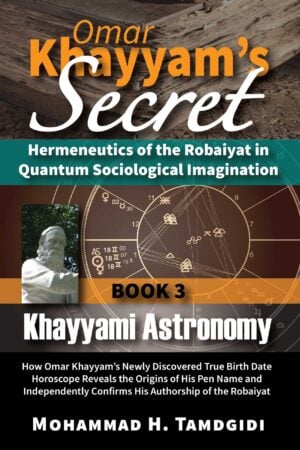Book Section: CHAPTER VI—The Robaiyat As a Critique of Fatalistic Astrology: Understanding Omar Khayyam’s Astronomy in Light of His Own Philosophical, Theological, and Scientific Outlook — by Mohammad H. Tamdgidi
$20.00
This essay titled “The Robaiyat As a Critique of Fatalistic Astrology: Understanding Omar Khayyam’s Astronomy in Light of His Own Philosophical, Theological, and Scientific Outlook” is the sixth chapter of the book Khayyami Science: The Methodological Structures of the Robaiyat in All the Scientific Works of Omar Khayyam, which is the sixth volume of the twelve-book series Omar Khayyam’s Secret: Hermeneutics of the Robaiyat in Quantum Sociological Imagination, authored by Mohammad H. Tamdgidi.
Description
Abstract
This essay titled “The Robaiyat As a Critique of Fatalistic Astrology: Understanding Omar Khayyam’s Astronomy in Light of His Own Philosophical, Theological, and Scientific Outlook” is the sixth chapter of the book Khayyami Science: The Methodological Structures of the Robaiyat in All the Scientific Works of Omar Khayyam, which is the sixth volume of the twelve-book series Omar Khayyam’s Secret: Hermeneutics of the Robaiyat in Quantum Sociological Imagination, authored by Mohammad H. Tamdgidi.
In this sixth chapter, Tamdgidi tries to integrate several findings that have emerged in this book as well as the earlier volumes of this series. To achieve such an integration, he argues, we should keep in mind that the five treatises studied so far in this book in music, on balance, on dividing a circle quadrant, in algebra, and on Euclid, constitute only some of what Khayyam accomplished as far as his scientific works are concerned. There are also other treatises to which Khayyam himself has referred in his extant writings, one being a treatise in arithmetic on extracting higher roots of numbers, and another a treatise (possibly longer than the brief one we studied) on a problem in a book on music. To the list we can also add two treatises attributed to Khayyam of which we know only their titles: one a brief treatise on nature, and another perhaps on geographical locations.
Then, there are other scientific works of Khayyam that are extant in a way that is different from a textual form, such as his astronomical observations and calculations leading to the reform of Iran’s solar calender, about which only a few pages of ephemeris data on the location of fixed starts are extant. In relation to this, we will have to also consider a set of three reports by Nezami Arouzi who in a contradictory way both acknowledges Khayyam’s training and authority in astrology while also noting that he did not believe in its rules. And then, there is a brief text including some astrological questions and answers that has been in an ambivalent way attributed to Khayyam.
We also have, of course, Khayyam’s extant philosophical and theological treatises, ones he himself characterized as being works in “universal science,” ones which we studied in Books 4 and 5 of this series in detail. And prior to those we also had a chance to study in depth the text of Khayyam’s birth horoscope, becoming familiar with possible interests Khayyam may have had in astrology, leading us to important findings as reported in Books 2 and 3 of this series.
Furthermore, there are other creative works that may be regarded as extant in a physical way, such as any influence Khayyam may have had on the architectural design of the North Dome in the historic Masjed Jāmeʾ complex in Isfahan, a topic advanced in some recent studies. Another consideration may be given to his literary works, such as Nowrooznameh (The Book on Nowrooz) or even his poetry compositions—provided that we are willing to let go of our modern discipline-bound lenses that lead us to think literary works or poetry are “separate” from scientific research engagements.
If we wish to develop an integrative understanding of Khayyam’s scientific works, in other words, we should note that such an effort will depend on integrating all the above folds of his work, leading us to question where we draw the boundaries of science and non-science, of extant and non-extant, and so on. Tamdgidi devotes this last chapter to making an effort at integrating Khayyam’s scientific treatises while having the above in mind.
In the next section of the chapter, having reviewed Khayyam’s non-extant titles and others in arithmetic and music he himself briefly comments on in his extant treatises in algebra and on Euclid respectively, Tamdgidi dwells in more detail on Khayyam’s differently extant contributions in arithmetic, drawing on the findings of the Iranian historian of science Jafar Aghayani Chavoshi. Aghayani Chavoshi’s commentary, himself drawing on several noted international and Iranian specialists in the field, suggests the extent to which Khayyam’s works have had an influence on later studies in mathematics, both Islamic and Western. This illustrates how being non-extant does not necessarily mean being entirely non-existent, even though proper acknowledgement of and attribution to his work may still be lacking on the part of those who have benefited from Khayyam’s work.
The fact is that the influence of Khayyam’s treatise on Euclid was also transmitted to Europe by way of the works of Khwājeh Naṣireddin Ṫoosi. Aghayani Chavoshi also shows, based on a textual comparison of Khayyam’s demonstration for Euclid’s fifth postulate (especially when demonstrating his third Proposition, to become his newly proposed Proposition 31) in Elements with that offered centuries later by Giovanni Gerolamo Saccheri, that the so-called Saccheri quadrilateral named after the latter must be duly credited to Khayyam as well. Such an influence has now been generally acknowledged, and one can find online references to it as “Khayyam-Saccheri Quadrilateral” in some sources. As another instance similar to the above, regarding the influence Khayyam’s treatise in algebra had on later Western works in solving cubic algebraic equations, Aghayani Chavoshi also notes how Khayyam’s solution to cubic equations also influenced later algebraic solutions found in the West.
The above observations, aside from the issues of cultural appropriation they raise, serve to show that being extant and non-extant is not a binary, as there can be gray areas in the middle, as the case of Khayyam’s work illustrate. Other than his five extant scientific treatises studied in this volume on one hand, and the non-extant treatises on nature and geography (possibly related to meteorology), about which nothing is known, on the other hand, we have cases where Khayyam’s works could have been, and were, studied by other scholars, and were drawn on by them, a process through which the explicit and direct acknowledgment of his contributions gradually, advertently or not, faded, yet remained differently extant.
Tamdgidi’s point in the above is to illustrate the fact that what we consider to be extant or not, scientific or not, and so on involving similar binaries, also depends on our own classificatory notions and ideas about them, and the gray areas between the binary poles can also depend on our own modern cultural and academic notions of disciplinarity and of the so-called “academic cultures” telling us what should pass or not as science. In his view, one of the most important illustrations of both aspects of what is discussed above, both in terms of considering the differently extant works of Khayyam, and how their classification as contributions in science has been influenced by our own thinking in modern times about what passes as science, is Khayyam’s contribution as an astronomer and its relation to astrology.
In a following section, drawing again on the views of Aghayani Chavoshi, Tamdgidi outlines the contribution Khayyam made to the reform of Iran’s solar calendar, producing images of a few extant pages from Khayyam’s ephemeris on the position of fixed stars. Tamdgidi also reports on another tract on astrological questions and answers ambivalently attributed to Khayyam by a compiler of various philosophical, theological, scientific, and astrological texts, a tract whose attribution to Khayyam has been generally dismissed without adequate and proper study, partly due to misunderstandings of what Nezami Arouzi reports in Chahar Maqaleh (Four Discourses) about Khayyam’s attitude toward astrology.
Tamdgidi argued that such ready dismissals of any material relating to astrology as being attributable to Khayyam, simply because they deal with astrology, are unfounded and poorly grounded on misunderstandings of what has been reported about Khayyam’s interest in astrology, or lack thereof. Today astrology is regarded as a pseudoscience, but that is not how it was treated in Khayyam’s time. It is true that especially the official and orthodox texts of Islam look down on astrology since it implies powers determining the course of the universe other than God. But Islamic thinkers, such as Avicenna, have also distinguished between the possibility of such influences and the extent of knowledge scientists have of them. Many Islamic scientists such as Biruni and Khwarazmi were trained in both astronomy and astrology, having their own opinions about the latter. Those who ignore the historical context of astrology and impose on the past what biases they hold today about astrology are in fact, in Tamdgidi’s view, themselves practicing pseudoscience, since without even studying old texts in the historical contexts in which they were written, they simply dismiss any influence astrological considerations had on the works of early Islamic scientists.
In fact, the author argues, the astrological tract supposedly attributed to Khayyam serves an evidential purpose that cannot be denied outright. Given it exists, we have now evidence that someone within about two centuries of Khayyam’s passing (in AD 1123) considered it possible that Khayyam may have engaged in astrological discussions with others, on matters of everyday life, personal (love, marriage, illness, and so on) or broader (related to war and peace), and that he was regarded as an authority in astrological matters, worthy of inclusion in a collection of (for that time) serious studies in a manuscript. The anonymous editor chose to include it among a series of relevant sources (relative to his times) on philosophy, theology, geometry, astronomy, logic, and other astrological texts. Therefore, we do not even have to accept or dismiss the attributability of the text to Khayyam, if we consider it noteworthy that in times closer to when Khayyam lived, it was possible to consider (“to think”) that an astrological text could be attributed to Khayyam. For Tamdgidi, that is itself significant and of evidential value.
In a following section, Tamdgidi revisits the three stories Nezami Arouzi reports about Khayyam in the astronomy/astrology section of his Chahar Maqaleh (Four Discourses). He concludes that Nezami Arouzi’s stories show how the kings expected astrological functions from those they hired to perform the job, and this indicated that despite whatever sanctions Islamic worldview imposed on the practice, it was a matter of common practice and expectation that astrologers be consulted in tasks ranging from hunting expeditions to waging battles and wars. If this was the case, why should we find it odd to see an editor include an astrological question and answer account in his collection of writings within two centuries of Khayyam’s passing, supposing that the account may have been related to Omar Khayyam?
The best way Nezami Arouzi’s contradictory portrayal of Khayyam’s attitude toward astrology can be reasonably reconciled and explained, in Tamdgidi’s view, is that Khayyam was in fact trained, and famed in his time for having been an authority, in astrology while not necessarily believing in it fully and accepting certain interpretations of it. In fact, in Tamdgidi’s view, the fact that Nezami Arouzi ends up offering stories that contradicts his own opinion of Khayyam’s astrological practice is itself a strong evidence for the fact that Khayyam was indeed interested in astrology, but from his own critical point of view. Again, we should note that Nezami Arouzi did not cite even a single story or anecdote in his book regarding Khayyam’s “astronomy” in its purely technical aspects having to do with, say, leading a groups of astronomers for reforming Iran’s solar calendar, or building an observatory in Isfahan, or such activities. A fourth of his book is devoted to the role astrologers play in royal courts, and it is precisely in that capacity that he narrated his stories about Khayyam.
In another section, Tamdgidi tries to provide an integrative understanding of Khayyam’s astronomy in light of Khayyam’s own philosophy, theology, science, and art. If we consider carefully the relation of all the five extant scientific treaties of Khayyam studied in this volume, Tamdgidi states, we notice something very interesting. What unites them all as a common thread is an interest in ratio and proportionality. It appears that Khayyam had a deep, enduring scientific interest in the theory and practice of ratio and proportionality.
From a bird eye’s point of view, the picture that emerges from the study of Khayyam’s scientific treatises is that Khayyam was trying to understand ratio and proportionality away from an atomistic vision of existence as comprised of separate things, in favor of one that treats existence as a unitary reality. Khayyam, in search of answers to the puzzles of existence, had sensed the significance of ratio and proportionality as pathways of moving from knowns to unknowns, and such an approach can only be effective when a unitary vision of reality is recognized and maintained, rather than maintaining an atomistic vision of reality comprised of separate things without any meaningful relation among them assumed to begin with. After all, if existents are separate, one cannot expect that unknowns in one thing be found by way of the knowns in an entirely separate thing. But, if one maintains a philosophical and theological perspective that recognizes the unitary nature of all existence as created by a unity Necessary Being, then, it would be possible to logically entertain the possibility that by way of the knowns, unknowns can be found in the created universe, to the extent possible. In this sense the Khayyami science is deeply Islamic, since its starting point is the Towḥidi (توحيدى) principle of unity of all existence.
When considering all of Khayyam’s extant, non-extant, and differently extant scientific works, we encounter an interesting puzzle or seeming anomaly: Why do we not find any substantial works related to two most important scientific fields to which Khayyam made contributions during his lifetime, namely, calendar reform, and astronomy? Khayyam was, after all, primarily an astronomer, rather than a music analyst, balance inventor or user, architectural ornaments geometrist, algebra mathematician, or Euclid critique. Where is his astronomical works in all of this or elsewhere?
Tamdgidi’s answer to the question(s) is that Khayyam in fact did write two other major treatises in the field most central to his work as an astronomer and calendar reformer, and the reason we have not noticed it has to do with our own investigative lenses. The two major treatises were a collection of Robaiyat on which he was working lifelong, and another is the treatise Nowrooznameh (The Book on Nowrooz). It is not that his other works were not related to his work in astronomy, but they were in fact elements that were contributive to his work as an astronomer, the meaning of “astronomy” here being itself something we need to reconsider while changing our lenses to those he himself used, not the lenses we like to use from our own modern points of view.
We do not have to rely on secondary sources to judge whether Khayyam’s worldview allowed for astrological insights. Aside from Khayyam’s birth horoscope itself, we have evidence in Khayyam’s last keepsake treatise on the universals of existence that he regarded the stars and planets as expressive of conscious and self-reflective forces to which intellects and souls are assigned and are involved in governing their respective spheres.
Khayyam’s ontology of existence as outlined in his keepsake treatise on the universals of existence is, for all practical purposes, a delineation of the ontology of his own alternative astrological outlook. The central thesis of his Islamic creationist evolutionary worldview as presented in that treatise, is the “succession order,” suggesting that God created the first, active, intellect or world consciousness, endowed with its self-reflective soul and resulting sphere of action, from whom a series of intellects, and their associated souls and spheres emanate down the ray of creation, ending in the evolution of humankind on Earth, an agency that can become truly human only if it awakens to its place in the succession order of God’s created universe, thereby embarking upon a return spiritual journey in search of its Beloved source.
The basic point for us to note is how, for Khayyam, God’s created world is a relatively self-reliant substance, comprised of two types, the body, and the spirit, the latter being itself of two kinds, the intellect and soul. The architecture of the world, therefore, allows for a self-reflective evolutionary process of beginning and returning to God. The central feature of this worldview, therefore, is that for Khayyam human consciousness and intentionality has an objective basis in the substance of the created world, thereby ruling out an absolutely fatalistic astrological worldview where everything is predetermined and subject to blind forces. On the contrary, Khayyam establishes in his keepsake treatise a participatory worldview in which humankind, while subject to structural forces of the universal substance as evolving through the succession order, can also play its part in charting its own course using its self-reflective powers of intellect, provided that it becomes awakened to its place in the succession order and takes upon the spiritual duties required to make the journey back to its source during its brief lifetime. So, it has to steal any opportunity during such a lifetime, to turn here and now into an opportunity to cultivate its self-reflective intellect and spirituality in order to understand who he or she is and where he or she is (or must be) going.
If Khayyam’s keepsake treatise on the universals of existence provides his own alternative ontology of astrological theory and practice as a critique of fatalistic schools or interpretations of astrology, his theological treatises provide the epistemology, or way of knowing God, that make it possible for humankind to awaken to its place in the succession order and conduct his or her spiritual life in such a way that before the death of the body, spiritual fulfillment is achieved in terms of understanding where one has come from and where one must go to in the succession order of God’s creation.
It is here that one can truly appreciate why a poetic intervention that transcends artificial binaries and fragmentations of everyday life—brought on, among others, by the contradiction of bodily and spiritual substance types in the personal sphere, but also of the same also in broader social life—becomes existentially necessary. The language of poetry offers an opportunity to advance the sensible, emotional, and intellective dimensions of inner life, while also cultivating the necessary attitudes to others in a social life that would be most conducive to the requirements of human spiritual evolution.
It is in the context of the above considerations that the purpose of the Robaiyat as a critique of fatalistic astrology can be best understood.
Being a critique of fatalistic astrology sums up clearly what the purpose of a collection of Robaiyat was in the mind of the astronomer-poet Omar Khayyam. Poetry was not a marginal, but an essential and pivotal, the core, of Khayyam’s astronomy as a critique of fatalistic astrology, using the latter’s tropes, concepts, and perspectives as a framework for performing the necessary task of awakening humanity in the “coming and going” succession order of God’s creation.
Recommended Citation
Tamdgidi, Mohammad H. 2023. “CHAPTER VI—The Robaiyat As a Critique of Fatalistic Astrology: Understanding Omar Khayyam’s Astronomy in Light of His Own Philosophical, Theological, and Scientific Outlook.” Pp. 623-676 in Omar Khayyam’s Secret: Hermeneutics of the Robaiyat in Quantum Sociological Imagination: Book 6: Khayyami Science: The Methodological Structures of the Robaiyat in All the Scientific Works of Omar Khayyam. (Human Architecture: Journal of the Sociology of Self-Knowledge: Vol. XIX, 2023. Tayyebeh Series in East-West Research and Translation.) Belmont, MA: Okcir Press.
Where to Purchase Complete Book: The various editions of the volume of which this Book Section is a part can be ordered from the Okcir Store and all major online bookstores worldwide (such as Amazon, Barnes&Noble, Google Play, and others).
Read the Above Publication Online
To read the above publication online, you need to be logged in as an OKCIR Library member with a valid access. In that case just click on the large PDF icon below to access the publication. Make sure you refresh your browser page after logging in.
